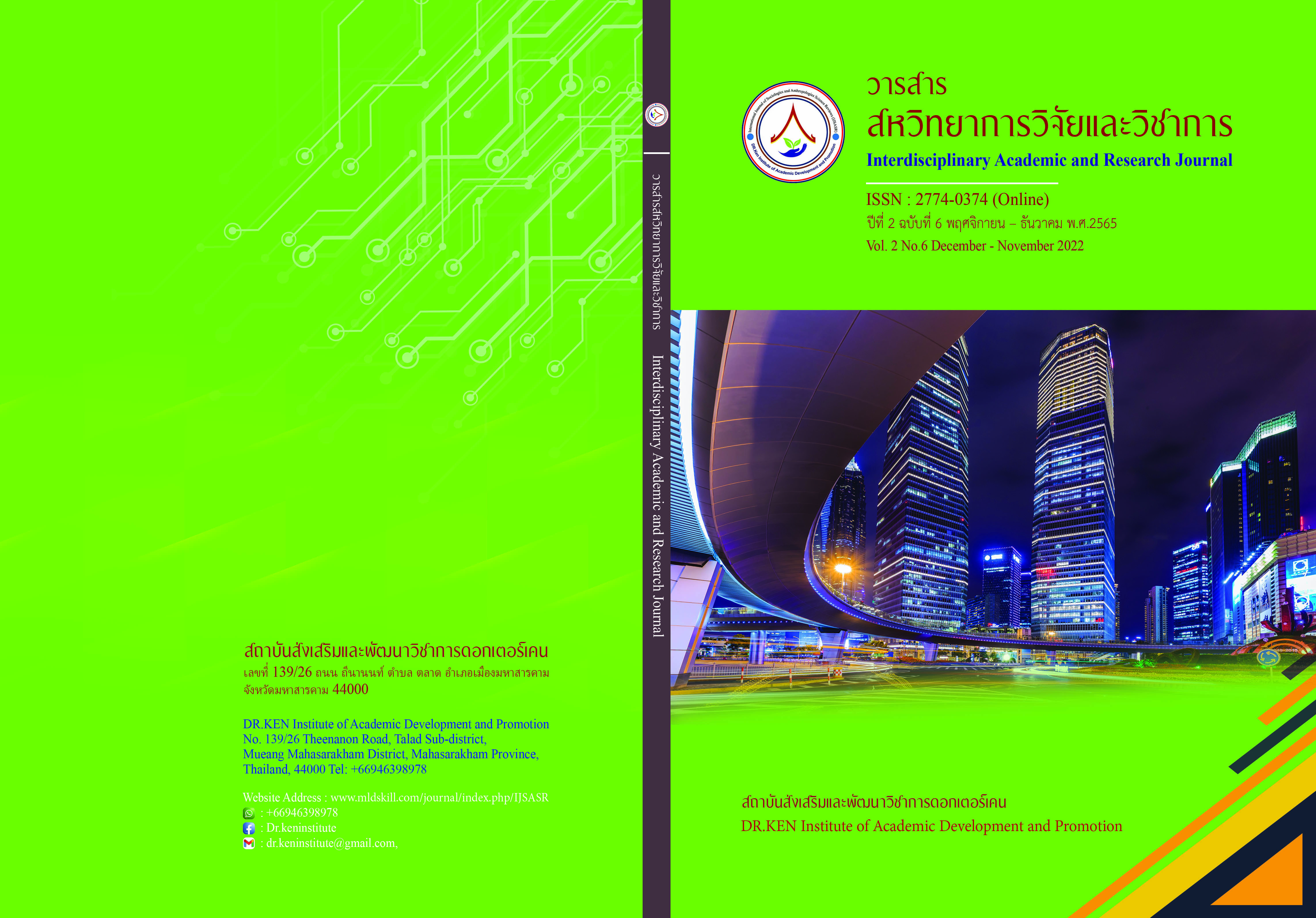Guidelines for the Implementation of Safe Schools of Educational Institutions under District Secondary Education
DOI:
https://doi.org/10.14456/iarj.2022.171Keywords:
Approach; , Safety SchoolAbstract
Education contributes to the development in all aspects of the community, society, and nation, therefore the management of education can develop human potential is the quality of education, which reflects the efficiency of educational institutions in managing education research this time intended for : (1) To study current and desirable conditions. The implementation of safety measures for students of the school. and (2) To study current Guidelines for the implementation of "safe schools" for students of the school. The research was divided into 2 phases, namely, Phase 1, to study the current and desirable conditions for the implementation of safety education institute measures. target group. The target group is the school director or deputy school director responsible for the event. Safe school, 1 person, 1 teacher responsible for safe school work, 1 person chairman of the Board of Basic Education, 1 student council president. Of each school including 4 students per school under the Office of Secondary Educational Service Area Kalasin in the academic year 2019, 55 theaters totaling 220 people. The instrument used for gathering the data was the rating-scale questionnaire which has a conformity Index between 0.80-1.00, discrimination 0.31–0.88, and reliability 0.86. Second: Study guidelines for the implementation of "safe schools" of educational institutions under the District Secondary Education Kalasin Office. The sample was 12. The instrument used for gathering the data was an interview questionnaire. 1 person chairman of the Board of Basic Education, 1 student council president. Research tools were interview forms, and statistics used in the research were Mean, Standard Deviation, and Percentage. The research findings were: (1) The results of school safety studied under District Secondary Education Kalasin Office of the school directors and teachers show that: overall the current conditions were at high, desirable conditions were at highest. (2) The results of the creation of guidelines for the implementation of safe schools of educational institutions for students of the school under District Secondary Education Kalasin Office 4 were: 1) Physical environment guidelines for the implementation of 4 items. 2) Social environment guidelines for the implementation of 7 items. 3) Security service arrangement guidelines for the implementation of 3 items. And 4) Welfare education guidelines for the implementation of 4 items.
References
กฤษฎา ศรีสุชาติ จําเนียร พลหาญ และสมชาย วงศ์เกษม. (2559). การพัฒนาตัวบ่งชี้และคู่มือโรงเรียนปลอดภัยของสถานศึกษาสังกัดสำนักงานคณะกรรมการการศึกษาขั้นพื้นฐาน. ว.มรม. (มนุษยศาสตร์และสังคมศาสตร์. 10 (3), 259-272.
ชนกานต์ สกุลแถว. (2559). ปัจจัยที่มีความสัมพันธ์กับพฤติกรรมความปลอดภัยในการใช้ห้องปฏิบัติการเคมีของนักเรียนชั้นปีที่ 1 ระดับปริญญาตรีของมหาวิทยาลัยแห่งหนึ่ง. วิทยานิพนธ์สาธณะสุขศาสตรมหาบัณฑิต. กรุงเทพฯ: มหาวิทยาลัยธรรมศาสตร์.
ชุติมา แก้วคำแสง. (2559). ความมั่นคงปลอดภัยในการใช้เทคโนโลยีสารสนเทศโรงเรียนสังกัดเทศบาลนครหาดใหญ่ จังหวัดสงขลา. วิทยานิพนธ์ศึกษาศาสตรมหาบัณฑิต. นนทบุรี:มหาวิทยาลัยสุโขทัยธรรมาธิราช.
ธีรศักดิ์ อุ่นอารมย์เลิศ สําเริง อ่อนสัมพันธุ์, ยุวรี ผลพันธิน, พิทักษ์ สุพรรโณภาพ. (2555). การพัฒนาระบบการบริหารงานการประกันคุณภาพการศึกษาของคณะศึกษาศาสตร์ มหาวิทยาลัยศิลปากร. วารสารศึกษาศาสตร์ มหาวิทยาลัยศิลปากร. 10(1), 174-197.
ธีระ รุญเจริญ. (2550). ความเป็นมืออาชีพในการจัดและบริหารการศึกษายุคปฏิรูปการศึกษา. กรุงเทพฯ: ข้าวฟ่าง.
นิฤมล วงค์อินพ่อ และ สถิรพร เชาวน์ชัย. (2565). การศึกษาสภาและแนวทางการจัดสภาพแวดล้อมที่เอื้อต่อการเรียนรู้ของเด็กปฐมวัย สังกัดสำนักงานเขตพื้นที่การศึกษาประถมศึกษาสุโขทัย เขต 2. วารสาร Journal of Roi Kaensarn. 7 (8), 306-321.
บุญชม ศรีสะอาด. (2560). การวิจัยเบื้องต้น. (พิมพ์ครั้งที่ 10). กรุงเทพฯ : สุวีริยาสาส์น.
ปราณี อินทรักษา. (2554). การศึกษาการดำเนินการรักษาความปลอดภัยของสถานศึกษาระดับมัธยมศึกษาสังกัดสำนักงานคณะกรรมการการศึกษาขั้นพื้นฐาน. วิทยานิพนธ์ครุศาสตรมหาบัณฑิต. กรุงเทพฯ: จุฬาลงกรณ์มหาวิทยาลัย.
พัชรา ก้อยชูสกุล และคณะ. (2559). การสร้างเสริมสุขภาพเด็กนักเรียนในโรงเรียนประถมศึกษา เขตอำเภอเมือง จังหวัดเชียงราย. วิทยานิพนธ์วิทยาศาสตรมหาบัณฑิต สาขาวิชาสุขศึกษา มหาวิทยาลัยราชภัฏเชียงราย.
มหาวิทยาลัยสุโขทัยธรรมาธิราช. (2532). นโยบายสาธารณะและการวางแผน หน่วยที่ 1-7. นนทบุรี: มหาวิทยาลัยสุโขทัยธรรมาธิราช.
ศรัณยา บุญประกอบ. (2549). การศึกษาการจัดบริการความปลอดภัยในโรงเรียนอนุบาลเอกชน เขตวัฒนา กรุงเทพมหานคร. สารนิพนธ์การศึกษามหาบัณฑิต. กรุงเทพฯ: มหาวิทยาลัยศรีนครินทรวิโรฒ.
ศิริพรรณ เกตุแก้ว. (2558). การดำเนินการรักษาความปลอดภัยตามมาตรการป้องกันและแก้ไขปัญหาทางสังคมของโรงเรียนประถมศึกษา. วิทยานิพนธ์ครุศาสตรมหาบัณฑิต. กรุงเทพฯ: จุฬาลงกรณ์มหาวิทยาลัย.
สำนักงานคณะกรรมการการศึกษาขั้นพื้นฐาน กระทรวงศึกษาธิการ. (2552). แนวปฏิบัติงานการจัดการศึกษาของสถานศึกษานิติบุคคลในสังกัดเขตพื้นที่การศึกษาสำนักงานคณะกรรมการการศึกษาขั้นพื้นฐาน. กรุงเทพฯ: โรงพิมพ์สำนักงานพระพุทธศาสนาแห่งชาติ.
สุชีรา ใจหวัง. (2560). การศึกษาการจัดการความปลอดภัยในสถานศึกษา สังกัดสำนักงานเขตพื้นที่การศึกษามัธยมศึกษา เขต 1. สารนิพนธ์การศึกษามหาบัณฑิต. กรุงเทพฯ: มหาวิทยาลัยศรีนครินทรวิโรฒ.
สุวณีย์ ศรีวะรมย์ ศักดิ์ไทย สุรกิจบวร และ ผศ.ดร.วาโร เพ็งสวัสดิ์. (2555). สภาพและปัญหาการดำเนินการเกี่ยวกับความปลอดภัยด้านอุบัติเหตุของนักเรียนในโรงเรียนสังกัดสำนักงานเขตพื้นที่การศึกษา ในจังหวัดนครพนม. วารสารมหาวิทยาลัยนครพนม. 2 (2), 68-75.
อินทิรา บริบูรณ์. (2556). การจัดสภาพแวดล้อมโรงเรียนที่เอื้อต่อการเรียนรู้ของนักเรียนเครือข่ายโรงเรียนนานาชาติเวลล์ส สังกัดสำนักบริหารงานคณะกรรมการส่งเสริมการศึกษาเอกชน . สารนิพนธ์. กรุงเทพฯ: มหาวิทยาลัยศรีนครินทรวิโรฒ.
Chinekesh, A. (2017). Exploring the youth experience about sense of social security: a qualitative study. Electronic Physician, 9 (12), 6019-6020.
Downloads
Published
How to Cite
Issue
Section
License
Copyright (c) 2022 ปัญญ์ชิตา สมบัติเพิ่ม

This work is licensed under a Creative Commons Attribution-NonCommercial-NoDerivatives 4.0 International License.
Copyright on any article in the Interdisciplinary Academic and Research Journal is retained by the author(s) under the under the Creative Commons Attribution-NonCommercial-NoDerivatives 4.0 International License. Permission to use text, content, images, etc. of publication. Any user to read, download, copy, distribute, print, search, or link to the full texts of articles, crawl them for indexing, pass them as data to software, or use them for any other lawful purpose. But do not use it for commercial use or with the intent to benefit any business.
















.png)


